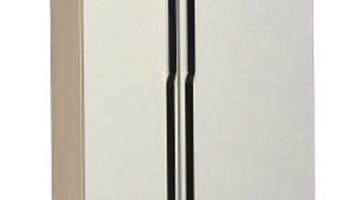My KitchenAid Refrigerator's Main Frame Between the Freezer & Refrigerator Is Too Hot
Warmth coming from the outside of your KitchenAid refrigerator or freezer unit usually is not a cause for concern. But occasionally it can signify an imminent breakdown, or perhaps that an equipment failure has already occurred. Having an idea of the inner workings of your refrigerator helps you determine the seriousness of a problem, or whether or not what you are feeling is the unit's normal operation.
Mullion

The strip of frame that runs between the two doors of your fridge and freezer is called the mullion strip. It exists whether your unit is a side-by-side model, a freezer-on-top model or a freezer-on-bottom model. Behind the strips rests something known as a heat loop. Its job is to warm the area near the door gaskets to keep condensation from forming on the outside of the unit.
Excessive Warmth
If the warmth you feel seems excessive, or is enough to cause the rubber gasket seals around the doors to yellow, you may have an equipment failure. It could be due to a failed condenser fan, or clogged or dirty evaporator coils. Both problems cause an insufficient movement of air so that the hot air inside can't be pulled and distributed away from the heat loop, causing it to overheat.
Coils
Evaporator coils are on the back of the refrigerator and are exposed. It isn't unusual for them to collect dust, lint and pet hair. Too much of any of these things can interfere with their job. The solution is to regularly clean the coils using a vacuum with a hose and brush attachment. Gently brush at and suck up anything clinging to the coils.
Fan
The failure of a condenser fan may also account for hot spots on the exterior of your KitchenAid refrigerator. It is simple to diagnose as you can hear a working fan running. If you don't hear the fan, call a repair technician to take a closer look. Without a working fan, a heated cabinet is the least of your problems, with the greatest being food spoilage when the unit fails completely.
External Factors
Once everything else checks out, you may discover that environmental factors are behind a hot fridge. Loading warm food into the refrigerator causes it to kick in and work harder to bring up the interior temperature of the unit. As a result, the cabinet grows warmer for a little while. Temperature and humidity outside may also affect how the unit runs and how warm it gets. The more often the door is opened, allowing controlled air to escape, the hotter the unit runs until it is able to normalize the interior temperature. When you first start up a refrigerator after it has been sitting at room temperature, it will grow warm until it has sufficiently cooled down on the inside.
Resources
Writer Bio
Angela Baird has been writing professionally since 1995. She has a wide range of life experiences from work with abused animals with the Humane Society, to more than 20 years of hands-on experience in the culinary arts. In addition, she keeps horses and does her own home improvements and home gardening.
Photo Credits
- Comstock/Comstock/Getty Images
More Articles
- What Does a Diffuser Do in a Refrigerator?
- What Is the Hottest Ambient Temperature at Which a Refrigerator Will Work?
- What Is the R-Value of Insulation on a Refrigerator?
- Refrigerator Condenser Fan Is Always Running
- Signs of Compressor Failure in a GE Refrigerator
- Fridgidaire Microwave Will Not Turn Off



